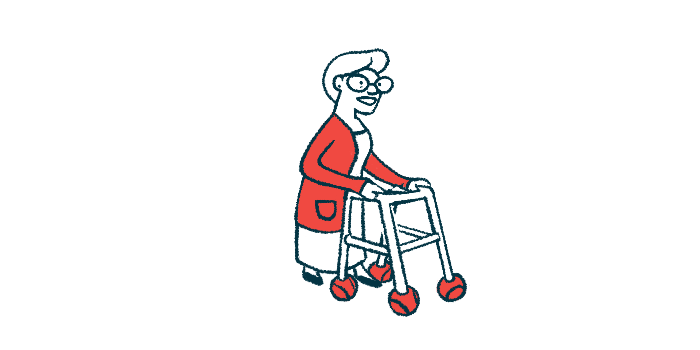Aging Process Weighs on Parkinson’s Symptoms With Later-age Onset
More nonmotor problems evident in older adults, but not all specific to disease

Older age at disease onset is associated with greater motor and nonmotor impairment in people with idiopathic Parkinson’s disease, according to a study by scientists in Luxembourg.
Nonmotor symptoms such as urinary incontinence and apathy in those diagnosed at older ages were found to be mainly driven by the natural aging process rather than disease-specific processes, while motor and cognitive problems were more disease-specific.
Results also showed that higher polygenic risk scores — related to the non-inherited genetic risk of developing Parkinson’s — were linked to an earlier age of onset, but not to symptom severity.
These findings suggest that Parkinson’s onset and progression may be driven by distinct factors, the researchers noted.
The study, “Age at onset as stratifier in idiopathic Parkinson’s disease – effect of ageing and polygenic risk score on clinical phenotypes,” was published in the journal npj Parkinson’s Disease.
Each person experiences different combinations of Parkinson’s motor and nonmotor symptoms.
Studies suggest those who develop Parkinson’s at an older age, defined as older than 50, show a faster progression of motor symptoms and cognitive decline. In comparison, early-onset patients appear to show a specific symptom profile, one with more motor complications such as erratic involuntary movements (dyskinesia) and uncontrolled muscle spasms (dystonia).
Parkinson’s symptoms with onset in older vs. younger adults
As such, age at disease onset has been proposed as a key indicator of a patient’s clinical profile and likely disease progression.
However, the impact of the natural aging process on different symptom profiles related to age at disease onset has yet to be explored.
In those with idiopathic Parkinson’s, where the disease is not associated with inherited mutations in disease-causing genes, earlier onset also has been linked to a higher polygenic risk score (PRS).
PRSs are calculated from the total number of genetic variants carried by an individual that are known to contribute to Parkinson’s risk. But the effect of polygenic risk on symptom profiles and disease severity remains unclear.
Researchers in Luxembourg set out to investigate the effect of age at onset on symptom profiles in idiopathic Parkinson’s patients, to separate the disease-related aging impact from the natural aging process, and to determine PRS’s effect on disease severity.
Their study included 430 people with idiopathic Parkinson’s alongside a group of 556 healthy adults as controls; all were participating in the nationwide observational Luxembourg Parkinson’s Study. None carried known Parkinson’s-causing mutations.
The Parkinson’s group comprised more males than females (67% vs. 33%), had a mean age of 61.8 at onset, a mean disease duration of 5.5 years, and a mean age at assessment of 67.3 years.
In both patients and controls, the occurrence and severity of motor and nonmotor problems were assessed with validated measures and interviews.
An older age at Parkinson’s onset was significantly associated with more severe motor symptoms, as well as more falls and walking problems, results showed.
No relationship was evident between age of onset and total hours of specific motor complications, such as dyskinesia and dystonia. However, a worse overall burden of these motor complications was significantly linked to an earlier age of onset.
Older age at onset also significantly associated with greater cognitive impairment, a poorer sense of smell and autonomic, or involuntary, body functions like urinary incontinence, and greater apathy, or a state of indifference.
These results highlighted that “patients with [a] higher [age at onset] experience more non-motor symptoms,” the researchers wrote.
Those with an earlier age of disease onset “experience a lower level of motor impairment, lower cognitive impairment and less global autonomic dysfunction, apathy and olfactory deficit,” the team added. However, they present “more motor complications even after adjusting for disease duration as a main determinant of disease severity.”
Impact of aging processes and polygenic risk scores
Researchers then looked at links between a person’s age at assessment and motor and nonmotor problems in patients and controls to separate the effect of the natural aging process on disease symptoms.
In both groups, older age at assessment was significantly associated with worse motor and autonomic function, more balance/walking problems, apathy, and urine incontinence, as well as poorer cognition and sense of smell.
Notably, when comparing the effects of aging between the two groups, the only significant differences were in disease severity, motor skills, motor complications, and cognitive function.
These findings suggested that “the majority of the observed significant non-motor [symptom] differences in PD [Parkinson’s disease] should be attributed rather to the physiological ageing process itself than age-specific dynamics in Parkinson’s,” the scientists wrote.
To generate polygenic risk scores, the researchers looked at 90 single DNA changes previously shown to be associated with Parkinson’s risk.
Consistently, a higher PRS was significantly linked to an earlier age of onset. However, there were no PRS-related effects related to symptom severity, even after adjusting for age at assessment and disease duration.
“Our findings suggest that PRS may increase the risk to develop PD but might not have an effect on the severity of the disease [clinical profile],” the team wrote.
“This observation is in favor of the hypothesis that initiation of the disease on one hand and the disease progression rate on the other might be driven by distinct factors,” the researchers concluded.







